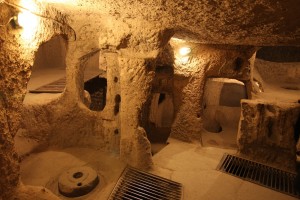Cappadocia Underground City Tours
Cappadocia Underground City Tours
There are many underground cities in Cappadocia and the biggest ones can be visited and seen. Every year, tens of thousands of domestic and foreign tourists explore these underground cities. The best way to visit the underground cities in Cappadocia is to join the daily excursion tours. Thanks to the daily excursion tours, you can have detailed information about the underground city with a professional guide, and you can visit the museum, the valley and different attractions in the same day. The two largest underground cities of Cappadocia are Derinkuyu Underground City and Kaymaklı Underground City. To see the underground city, you should join the Green tour.
Cappadocia Underground City
One of the most interesting and intriguing cultural riches unique to Cappadocia is the underground cities. If we consider that there are settlements carved under all the villages and towns in the Cappadocia region, which covers a total area of 25,000 km², there are perhaps more underground cities than anticipated. And such an underground network peculiar to the geological structure of the region is not found anywhere else in the world.
The underground cities of Cappadocia were built by carving the rocks down in volcanic tuff land. It is not yet known what tools people used to descend into the depths where such large settlements were created in ancient times, when there was no technology. In their dating, the traces left by ancient civilizations are used.
Derinkuyu Underground City
The first of Cappadocia’s deepest, widest and most amazing underground cities is Derinkuyu Underground City. Located on the Nevşehir – Niğde road and 30 km from Nevşehir, the underground city is located in Derinkuyu district. It has discovered in 1963, partly cleaned and opened for visitors in 1967. Right now it has 8 open floor that reaches 50 meters down, but if all of it is cleaned, its floors can be up to 12-13 and reaches a depth of 85 meters. This Cappadocia Underground City has total of 2,5 km cleaned, visitable area called after 52 water wells inside of it. These water wells are 60 – 70 meters deep and both meets the need for water supply and functions as a ventilation shaft. Some of these chimneys have no connection with the surface in order to prevent the enemy, which cannot come down during the sieges in the region, from mixing poison with water. This feature is one of the reasons why this Cappadocia underground city, which is so sheltered and equipped with a natural ventilation system, does not have a technological explanation.
Even if Cappadocia Underground Cities have similar features with their purpose and architecture, you will encounter higher equipment while visiting Derinkuyu Underground City. The floors of the underground city, which has a very uncertain entrance from the outside, are interconnected by narrow corridors. In order to prevent entry in case of danger, precautions were taken with huge round stones such as millstones that can be moved by pulling.
While living spaces, dining halls, kitchens, stables, mysteries and cisterns are places that can be seen in almost every Cappadocia underground city, there is also a missionary school whose ceiling is covered with barrel vaults in the region. The cross-shaped church is carved on the 2nd floor of the underground city and can be reached by going down the stairs from the 3rd and 4th floors.
Kaymaklı Underground City
One of the biggest Cappadocia Underground Cities is Kaymaklı Underground City. This underground city, which is almost half the size of Derinkuyu Underground City, is located in Kaymaklı Town, 20 km away from Nevşehir, and has been among UNESCO World Cultural Heritage since 1984. Its history is back to 8 BC Phrygian period and its reason was also to prevent Hittites and Arabian raids.
Although its actual depth reaches up to 8 floors, 4 floors of Kaymaklı Underground City are now open to visitors. The first floor was reserved for stables to make it easier for animals to go out, and passages were opened through the corridors opening from the stables to churches and other living areas. The entrance to the church on the 2nd floor, which was built with 2 apses and one nave, was controlled by sliders. When you enter the church, you will see the baptism stone placed in front of the apses and sitting platforms carved on the edges and you will encounter graves that are thought to belong to the church workers. Living areas, sitting, sheltering, and food rooms are spread over the 3rd and 4th floors.
Özkonak Underground City
Özkonak Underground City, which is 14 km away from Nevşehir Avanos, was built on the northern slope of İdiş Mountain where the tuff layer is the most intense. You will feel like going down in an apartment while visiting this Cappadocia underground city which has opened to visitors in 1972. Labyrinth tunnels, which are the main factors of connection between places in Cappadocia Underground Cities, are also exists here. The main difference of this city comparing to Derinkuyu and Kaymaklı underground cities is 5-8 cm small capillary holes opened for communication and ventilation. When the doors of the places are closed with sliding stones, the whole worldly connection is provided with these holes. Unlike other underground cities, the sliding stones were made not only for protection but also for fighting. After the entrance was closed with stones, small holes were carved on the tunnel to spear the enemy and pour hot oil.
The first floor of Özkonak Underground City, which has 4 floors, is divided into barns as the others, and the other floors are divided into sections such as living rooms, pantry, grape house and kitchen. The distance between the entrance and the exit is 10 kilometers wide, and it is believed that this underground city’s age is back to the 400s BC and is related to the Hittites.
Mazı Underground City
Mazı Underground City, which is 10 km east of Kaymaklı Underground City in Nevşehir and 18 km south of Ürgüp, takes its name from the village where it is located. It was found by chance by a shepherd in 1995 and opened to visitors. The main meaning of Mazı is ‘Ancient City’ and there are many rock tombs from the Early Roman and Byzantine periods in the valley where the village was founded.
The 8-floor underground city has entrances from 4 different locations and is covered with sliding stones with holes in the middle for lances to protect against enemies. The difference from other examples of barns at the entrance is the troughs carved into the rocks and the width of its areas. This is an indication that Mazı Underground City is home to an advanced society in animal husbandry. According to the estimates, 6,000 people live in Mazı Underground City at the same time.


